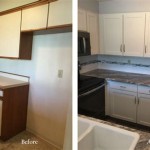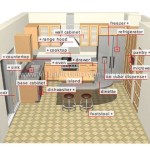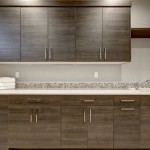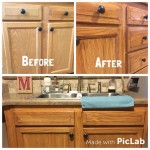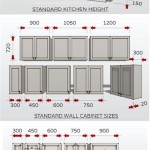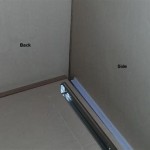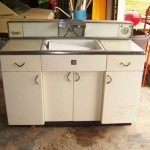Understanding Cabinet Component Names: A Comprehensive List
Cabinets are fundamental elements of residential and commercial spaces, serving as storage solutions and contributing significantly to the overall aesthetic. Whether for kitchens, bathrooms, offices, or workshops, a thorough understanding of cabinet components is crucial for designers, contractors, homeowners, and anyone involved in cabinet installation, repair, or modification. This article provides a comprehensive list of cabinet component names, detailing their function and significance within the broader cabinet structure.
This information assists in clear communication when discussing cabinet design, ordering parts, or troubleshooting issues. A precise vocabulary minimizes misunderstandings and ensures that projects proceed efficiently and accurately. The terminology presented encompasses both framed and frameless cabinet construction, covering a wide range of cabinet styles and configurations.
Key Point 1: Identifying the Core Structure – Cabinet Boxes and Framing
The cabinet box forms the primary structure of a cabinet. It consists of several key components that provide strength, stability, and enclosure. These include the sides, top, bottom, and back, each contributing to the overall integrity of the cabinet.
Sides (End Panels): The side panels, also known as end panels, are the vertical components that define the width of the cabinet. They provide structural support and are often visible on exposed cabinet ends. In frameless cabinets, the sides are typically thicker to provide the necessary stability, as they are directly attached to the doors and drawers.
Top Panel: The top panel is the horizontal component that forms the upper surface of the cabinet box (excluding base cabinets with countertops). It provides support and helps maintain the cabinet's squareness. In wall cabinets, the top panel often has a lip or edge that helps secure it to the wall.
Bottom Panel: The bottom panel is the horizontal component that forms the lower surface of the cabinet box. It supports the weight of the contents stored within the cabinet. In base cabinets, the bottom panel often rests on a toe kick, further elevating it and protecting it from moisture.
Back Panel: The back panel encloses the rear of the cabinet box. It provides additional structural support and helps prevent the cabinet from racking or twisting. Back panels can be constructed from various materials, including plywood, particleboard, or hardboard. In some cases, particularly with older or less expensive cabinets, the back panel may be partially open or made from thinner materials.
Frame (Face Frame): In framed cabinets, a face frame is attached to the front of the cabinet box. The frame consists of vertical pieces called stiles and horizontal pieces called rails. The frame provides additional rigidity, a surface for attaching doors and drawer fronts, and often a decorative element.
Stiles: Stiles are the vertical members of the face frame. They run from the top to the bottom of the cabinet box and define the overall height of the cabinet. In most cases, the stiles are visible when the cabinet doors are closed.
Rails: Rails are the horizontal members of the face frame. They run between the stiles and define the width of the cabinet opening. There are typically two rails, a top rail and a bottom rail. Sometimes, a center rail is present for added strength or design purposes.
Mullions: Mullions are vertical dividers within a cabinet door or glass panel. They create separate panes of glass or panels and add visual interest to the door design.
Key Point 2: Components Related to Accessibility – Doors, Drawers, and Shelves
The functional aspects of a cabinet largely depend on its doors, drawers, and shelves. These components provide access to the interior storage space and contribute to the overall organization and usability of the cabinet.
Door: The door is a hinged or sliding panel that provides access to the cabinet's interior. Doors come in various styles, including slab doors, raised panel doors, shaker doors, and glass doors. The door's construction and material significantly impact the cabinet's aesthetic.
Door Panel: The central segment of a cabinet door, frequently recessed or raised, introducing aesthetic variety. Materials range from wood and MDF to glass or metal inserts, each option influencing the door's overall appearance.
Hinges: Hinges are the hardware that allows the door to swing open and closed. There are various types of hinges, including concealed hinges, surface-mounted hinges, and self-closing hinges. The choice of hinge affects the door's appearance and functionality.
Drawer: A drawer is a sliding box that pulls out from the cabinet to provide access to its contents. Drawers are typically used for storing smaller items or items that need to be easily accessible.
Drawer Box: The drawer box is the structural component of a drawer. It consists of the drawer sides, drawer front, drawer back, and drawer bottom. The drawer box must be strong enough to support the weight of the drawer's contents.
Drawer Front: The drawer front is the visible panel on the front of the drawer. It matches the cabinet doors and contributes to the overall aesthetic of the cabinet.
Drawer Slides: Drawer slides are the hardware that allows the drawer to slide in and out of the cabinet. There are various types of drawer slides, including ball-bearing slides, roller slides, and soft-close slides. The type of slide affects the drawer's smoothness and ease of use.
Shelves: Shelves are horizontal panels that provide storage space within the cabinet. Shelves can be fixed or adjustable, allowing for customization of the storage space. They can be constructed from various materials, including wood, glass, or metal.
Shelf Supports (Shelf Pins or Clips): Shelf supports are the hardware that holds the shelves in place. They can be pins, clips, or brackets that attach to the cabinet sides or back. Adjustable shelves require shelf supports that can be easily moved to different positions.
Key Point 3: Essential Hardware and Finishing Elements
Hardware and finishing elements play a crucial role in the functionality and appearance of cabinets. These components include knobs, pulls, molding, and other decorative features that enhance the cabinet's overall design.
Knob: A knob is a small, rounded handle used to open doors and drawers. Knobs are typically attached with a single screw and come in various styles and materials.
Pull: A pull is a longer, bar-shaped handle used to open doors and drawers. Pulls are typically attached with two screws and provide a more substantial grip than knobs.
Toe Kick: The toe kick is a recessed space at the base of base cabinets. It allows individuals to stand closer to the cabinet without bumping their toes, improving comfort and accessibility.
Legs (Feet): Cabinet legs or feet provide support and elevation for the cabinet. They are often used on freestanding cabinets or vanities to raise them off the floor.
Molding (Trim): Molding is decorative trim that is used to enhance the appearance of cabinets. It can be applied to the top, bottom, or sides of the cabinet and comes in various styles, including crown molding, base molding, and edge banding.
Crown Molding: Crown molding is decorative trim that is applied to the top of wall cabinets, adding a finishing touch and creating a more formal look.
Light Rail Molding: Light rail molding is a type of trim that is installed under wall cabinets to conceal under-cabinet lighting fixtures. It provides a clean and finished look while also directing the light onto the countertop.
Fillers: Fillers are narrow strips of wood or other material that are used to fill gaps between cabinets or between a cabinet and a wall. They provide a seamless and professional look while also preventing dust and debris from accumulating in the gaps.
End Panel Finish: The treatment applied to the exposed sides of a cabinet, matching the door style or providing a contrasting element. This can be paint, stain, veneer, or laminate, contributing to the unified aesthetic.
Countertop: While technically not part of the cabinet itself, the countertop is a crucial element that sits atop base cabinets, providing a work surface and impacting the overall look of the kitchen or bathroom. Countertops can be made from various materials, including granite, quartz, marble, laminate, and solid surface.
Screws and Fasteners: Various types of screws and fasteners are used to assemble and install cabinets. These include wood screws, drywall screws, cabinet screws, and construction adhesives. The correct choice of fasteners is essential for ensuring the structural integrity of the cabinet.
Understanding these cabinet component names allows for greater clarity in communication, efficient project management, and informed decision-making in all aspects of cabinet-related endeavors. It enables effective dialogue between designers, installers, homeowners, and suppliers, leading to successful and satisfying results.

Cabinet Parts And Profiles

Kitchen Cabinet Parts Names Google Search Plans Cabinets Making

Kitchen Cabinet Terms Cabinets Of The Desert

Cabinets What Is The Name Of This Part Drawers Home Improvement Stack Exchange

Cabinets What Is The Name Of This Part Drawers Home Improvement Stack Exchange

7 Best Kitchen Cabinet Materials To Protect You From Poor Quality Horrors

Kitchen Cabinet Parts Terminology Granite Quartz Countertops Cabinets Factory

Kitchen Cabinet Parts Terminology Granite Quartz Countertops Cabinets Factory
Whirlpool Et8wtexvq03 Parts List Trible S

Graphic Standards For Architectural Cabinetry Life Of An Architect
Related Posts

